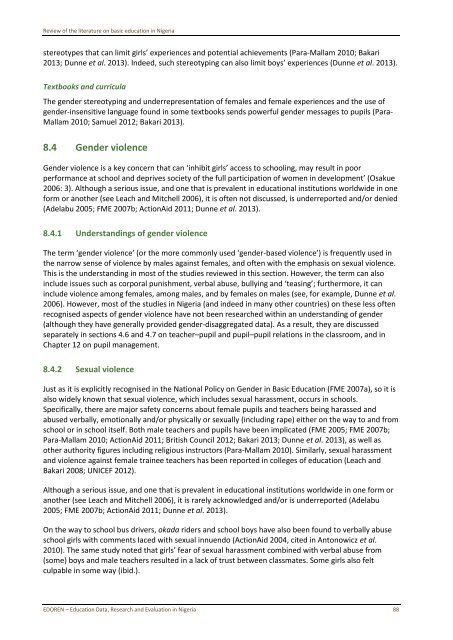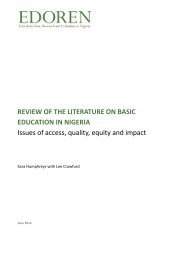review-of-the-literature-on-basic-education-in-nigeria-june-2014-3-1
review-of-the-literature-on-basic-education-in-nigeria-june-2014-3-1
review-of-the-literature-on-basic-education-in-nigeria-june-2014-3-1
Create successful ePaper yourself
Turn your PDF publications into a flip-book with our unique Google optimized e-Paper software.
Review <str<strong>on</strong>g>of</str<strong>on</strong>g> <str<strong>on</strong>g>the</str<strong>on</strong>g> <str<strong>on</strong>g>literature</str<strong>on</strong>g> <strong>on</strong> <strong>basic</strong> educati<strong>on</strong> <strong>in</strong> Nigeriastereotypes that can limit girls’ experiences and potential achievements (Para-Mallam 2010; Bakari2013; Dunne et al. 2013). Indeed, such stereotyp<strong>in</strong>g can also limit boys’ experiences (Dunne et al. 2013).Textbooks and curriculaThe gender stereotyp<strong>in</strong>g and underrepresentati<strong>on</strong> <str<strong>on</strong>g>of</str<strong>on</strong>g> females and female experiences and <str<strong>on</strong>g>the</str<strong>on</strong>g> use <str<strong>on</strong>g>of</str<strong>on</strong>g>gender-<strong>in</strong>sensitive language found <strong>in</strong> some textbooks sends powerful gender messages to pupils (Para-Mallam 2010; Samuel 2012; Bakari 2013).8.4 Gender violenceGender violence is a key c<strong>on</strong>cern that can ‘<strong>in</strong>hibit girls’ access to school<strong>in</strong>g, may result <strong>in</strong> poorperformance at school and deprives society <str<strong>on</strong>g>of</str<strong>on</strong>g> <str<strong>on</strong>g>the</str<strong>on</strong>g> full participati<strong>on</strong> <str<strong>on</strong>g>of</str<strong>on</strong>g> women <strong>in</strong> development’ (Osakue2006: 3). Although a serious issue, and <strong>on</strong>e that is prevalent <strong>in</strong> educati<strong>on</strong>al <strong>in</strong>stituti<strong>on</strong>s worldwide <strong>in</strong> <strong>on</strong>eform or ano<str<strong>on</strong>g>the</str<strong>on</strong>g>r (see Leach and Mitchell 2006), it is <str<strong>on</strong>g>of</str<strong>on</strong>g>ten not discussed, is underreported and/or denied(Adelabu 2005; FME 2007b; Acti<strong>on</strong>Aid 2011; Dunne et al. 2013).8.4.1 Understand<strong>in</strong>gs <str<strong>on</strong>g>of</str<strong>on</strong>g> gender violenceThe term ‘gender violence’ (or <str<strong>on</strong>g>the</str<strong>on</strong>g> more comm<strong>on</strong>ly used ‘gender-based violence’) is frequently used <strong>in</strong><str<strong>on</strong>g>the</str<strong>on</strong>g> narrow sense <str<strong>on</strong>g>of</str<strong>on</strong>g> violence by males aga<strong>in</strong>st females, and <str<strong>on</strong>g>of</str<strong>on</strong>g>ten with <str<strong>on</strong>g>the</str<strong>on</strong>g> emphasis <strong>on</strong> sexual violence.This is <str<strong>on</strong>g>the</str<strong>on</strong>g> understand<strong>in</strong>g <strong>in</strong> most <str<strong>on</strong>g>of</str<strong>on</strong>g> <str<strong>on</strong>g>the</str<strong>on</strong>g> studies <str<strong>on</strong>g>review</str<strong>on</strong>g>ed <strong>in</strong> this secti<strong>on</strong>. However, <str<strong>on</strong>g>the</str<strong>on</strong>g> term can also<strong>in</strong>clude issues such as corporal punishment, verbal abuse, bully<strong>in</strong>g and ‘teas<strong>in</strong>g’; fur<str<strong>on</strong>g>the</str<strong>on</strong>g>rmore, it can<strong>in</strong>clude violence am<strong>on</strong>g females, am<strong>on</strong>g males, and by females <strong>on</strong> males (see, for example, Dunne et al.2006). However, most <str<strong>on</strong>g>of</str<strong>on</strong>g> <str<strong>on</strong>g>the</str<strong>on</strong>g> studies <strong>in</strong> Nigeria (and <strong>in</strong>deed <strong>in</strong> many o<str<strong>on</strong>g>the</str<strong>on</strong>g>r countries) <strong>on</strong> <str<strong>on</strong>g>the</str<strong>on</strong>g>se less <str<strong>on</strong>g>of</str<strong>on</strong>g>tenrecognised aspects <str<strong>on</strong>g>of</str<strong>on</strong>g> gender violence have not been researched with<strong>in</strong> an understand<strong>in</strong>g <str<strong>on</strong>g>of</str<strong>on</strong>g> gender(although <str<strong>on</strong>g>the</str<strong>on</strong>g>y have generally provided gender-disaggregated data). As a result, <str<strong>on</strong>g>the</str<strong>on</strong>g>y are discussedseparately <strong>in</strong> secti<strong>on</strong>s 4.6 and 4.7 <strong>on</strong> teacher–pupil and pupil–pupil relati<strong>on</strong>s <strong>in</strong> <str<strong>on</strong>g>the</str<strong>on</strong>g> classroom, and <strong>in</strong>Chapter 12 <strong>on</strong> pupil management.8.4.2 Sexual violenceJust as it is explicitly recognised <strong>in</strong> <str<strong>on</strong>g>the</str<strong>on</strong>g> Nati<strong>on</strong>al Policy <strong>on</strong> Gender <strong>in</strong> Basic Educati<strong>on</strong> (FME 2007a), so it isalso widely known that sexual violence, which <strong>in</strong>cludes sexual harassment, occurs <strong>in</strong> schools.Specifically, <str<strong>on</strong>g>the</str<strong>on</strong>g>re are major safety c<strong>on</strong>cerns about female pupils and teachers be<strong>in</strong>g harassed andabused verbally, emoti<strong>on</strong>ally and/or physically or sexually (<strong>in</strong>clud<strong>in</strong>g rape) ei<str<strong>on</strong>g>the</str<strong>on</strong>g>r <strong>on</strong> <str<strong>on</strong>g>the</str<strong>on</strong>g> way to and fromschool or <strong>in</strong> school itself. Both male teachers and pupils have been implicated (FME 2005; FME 2007b;Para-Mallam 2010; Acti<strong>on</strong>Aid 2011; British Council 2012; Bakari 2013; Dunne et al. 2013), as well aso<str<strong>on</strong>g>the</str<strong>on</strong>g>r authority figures <strong>in</strong>clud<strong>in</strong>g religious <strong>in</strong>structors (Para-Mallam 2010). Similarly, sexual harassmentand violence aga<strong>in</strong>st female tra<strong>in</strong>ee teachers has been reported <strong>in</strong> colleges <str<strong>on</strong>g>of</str<strong>on</strong>g> educati<strong>on</strong> (Leach andBakari 2008; UNICEF 2012).Although a serious issue, and <strong>on</strong>e that is prevalent <strong>in</strong> educati<strong>on</strong>al <strong>in</strong>stituti<strong>on</strong>s worldwide <strong>in</strong> <strong>on</strong>e form orano<str<strong>on</strong>g>the</str<strong>on</strong>g>r (see Leach and Mitchell 2006), it is rarely acknowledged and/or is underreported (Adelabu2005; FME 2007b; Acti<strong>on</strong>Aid 2011; Dunne et al. 2013).On <str<strong>on</strong>g>the</str<strong>on</strong>g> way to school bus drivers, okada riders and school boys have also been found to verbally abuseschool girls with comments laced with sexual <strong>in</strong>nuendo (Acti<strong>on</strong>Aid 2004, cited <strong>in</strong> Ant<strong>on</strong>owicz et al.2010). The same study noted that girls’ fear <str<strong>on</strong>g>of</str<strong>on</strong>g> sexual harassment comb<strong>in</strong>ed with verbal abuse from(some) boys and male teachers resulted <strong>in</strong> a lack <str<strong>on</strong>g>of</str<strong>on</strong>g> trust between classmates. Some girls also feltculpable <strong>in</strong> some way (ibid.).EDOREN – Educati<strong>on</strong> Data, Research and Evaluati<strong>on</strong> <strong>in</strong> Nigeria 88



